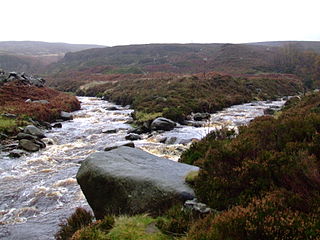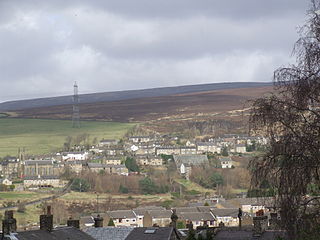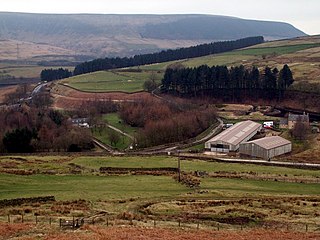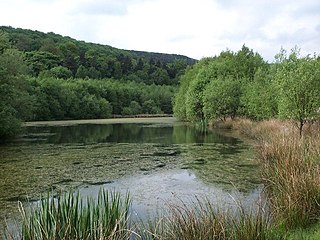

Longdendale is a valley in the Peak District of England, north of Glossop and southwest of Holmfirth. The name means "long wooded valley" and the valley is mostly in the counties of Derbyshire and Greater Manchester.


Longdendale is a valley in the Peak District of England, north of Glossop and southwest of Holmfirth. The name means "long wooded valley" and the valley is mostly in the counties of Derbyshire and Greater Manchester.
The eastern part of the valley is in the non-metropolitan county of Derbyshire and includes the village of Tintwistle and, further east, part of the Peak District National Park, with the last half-mile or so falling into the Metropolitan Borough of Barnsley in South Yorkshire. The western part of the valley, including the villages of Broadbottom, Mottram in Longdendale and Hollingworth is part of Tameside in the metropolitan county of Greater Manchester. The whole of Longdendale forms the easternmost extension of the lands within the historic boundaries of Cheshire.
The River Etherow, a tributary of the River Mersey, rises south of Holmfirth and then flows through a chain of six reservoirs known as the Longdendale Chain: Woodhead Reservoir, Torside Reservoir, Rhodeswood Reservoir, Valehouse Reservoir, Bottoms Reservoir and Arnfield Reservoir. There was a seventh reservoir at Hollingworth, but it was abandoned in 1990 and now forms part of Swallows Wood Nature Reserve. [1]
Hollingworth and Mottram were part of the Longdendale urban district in the administrative county of Cheshire from 1936. In 1974 the district was absorbed by Tameside Metropolitan Borough.
There is a Roman fortlet at Highstones on the south-facing slope overlooking Torside Reservoir. It is an oval-shaped area, with an obvious ditch, and about 82 yards (75 m) across. A footpath runs immediately to the north of it, and to the west is Highstones Farm. A Roman road may have run along the valley connecting it with Melandra Castle (Glossop). [2]
The lordship of Longdendale was an ancient feudal estate encompassing the medieval manors of Godley, Hattersley, Hollingworth, Matley, Mottram, Newton, Staley, Tintwistle and Werneth. The lordship was created by the Earl of Chester in the late twelfth century; William de Neville was the first lord of Longdendale, as appointed by the Earl of Chester. [3] Buckton Castle, near Carrbrook, was probably built by William de Neville in the late twelfth century [4] and was also probably the centre of lordship of Longdendale as it is the only castle within the lordship. [5] One of the privileges of the lordship was to carry out trial by combat. The lordship of Longdendale was passed from de Neville to his son in law, Thomas de Burgh, in 1211 on his death. The lordship reverted to the control of the crown in 1357, and remained under crown control until 1374. The lordship was given to Matilda Lovell and the Lovells controlled Longdendale until 1465 when control again reverted to the crown. The lordship was granted to Sir William Stanley in 1489, however the lordship once again reverted to the crown when Stanley was executed in 1495 as a supporter of Perkin Warbeck. In 1554 the lordship was granted to Richard Wilbraham. [6] Tollemache family inherited lordship of Longdendale from the Wilbrahams in the 1690s. [7] It was part of the Hundred of Macclesfield. An estate survey, or 'Extent' of the lordship for 1360 was published by the Record Society of Lancashire and Cheshire in July 2005.

A packhorse route called a saltway was maintained from the Middle Ages onwards for the purpose of allowing the export of salt from the Cheshire wiches of Nantwich, Northwich and Middlewich across the Pennines. The passing trade brought prosperity to settlements along the route. The importance of the salt trade along such saltways is shown by surviving placenames; for example Salter's Brook ( SK137999 ) is where the saltway forked, with one route leading to Wakefield and another to Barnsley. The stone Lady Shaw Bridge still exists at this point, as do the ruins of an old inn. The bridge is just wide enough for a packhorse, though it is suspected that the bridge may have originally been wider and was deliberately narrowed when the Saltersbrook turnpike was built, to prevent vehicles bypassing the toll barrier. [8]
The turnpike road from Manchester to Saltersbrook connected to further turnpikes for Yorkshire destinations and was built in the mid-18th century, based on the older saltway route.
The Longdendale catchment exceeds 30 square miles (78 km2) and has an annual rainfall of 1,330 millimetres (52.5 in). The civil engineer John Frederick Bateman recognised the potential and conceived a plan to deliver this water to Manchester and Salford, while still maintaining the flow in the River Etherow that was needed to power the mills of Tintwistle and Glossop. The six reservoirs have a capacity of 190,000 m3 (42,000,000 imp gal). A tunnel was built at a depth of 200 feet (60 m) to carry the water from Longdendale into the valley of the River Tame. The Manchester Corporation Waterworks Act 1847 (10 & 11 Vict. c. cciii) (9 July 1847) was passed to allow the land to be acquired and construction to commence. [9]
The first railway line between Manchester and Sheffield was constructed between 1839 and 1845 on the south side of the reservoir chain by 1,500 navvies of whom many died and most suffered illness. The three-mile-long double Woodhead Tunnel was, for a time, the longest tunnel in the country. It was replaced by a single, larger tunnel in 1954. The first tunnel was subsequently used by CEGB to reroute the main high-voltage link up the valley and through the National Park underground. The railway line ceased to be economical, and in 1970 the passenger service ceased, followed in 1981 by the goods service. The passenger service was adversely affected by the requirement to keep the Hope Valley line open, whilst the freight service was affected by the falloff in Trans-Pennine coal traffic. The track was lifted in 1986. There have been plans to re-open the railway at various times since it was closed, but none have gained planning approval.

After the rail line was closed, the trackbed was taken up and the Longdendale Trail constructed along its route. It is now part of the Trans-Pennine Trail (Sustrans National Cycle Route 62 [10] ) which, in its turn, is part of the 2,000-mile (3,200 km) European walking route E8 from Liverpool to Istanbul. Holme Moss and Woodhead Pass are on the chosen route of the 2014 Tour de France, during the second stage between York and Sheffield. [11]
The Pennine Way crosses Longdendale, descending from Bleaklow to the south and ascending Black Hill to the north. The youth hostel at Crowden is a traditional stop after the first day's walk from Edale. The circular walk known as 'The Longdendale Edges' takes in the high ground (at about the 1,000–1,500-foot (300–460 m) level) on both sides of the valley. It is about 17 miles (27 km) long and is 'not recommended in doubtful weather'. The detailed route, clockwise from Crowden Youth Hostel, is given in Peak District Walking Guide No.2, published by the Peak Park Planning Board.
Torside Reservoir is home to Glossop Sailing Club. [12]
The M67 motorway starts at the M60 motorway in Manchester and heads east where it currently terminates at Mottram in Longdendale. There were plans in the 1960s to extend it through the National Park to the M1 motorway and Sheffield [13] but it was never built. From here the A628 runs through the valley to join the A616.
As of January 2008 there are advanced plans to improve the A628 route by bypassing Mottram and Tintwistle to the north with a spur to the A57 road. Known as the 'A57/A628 Mottram-in-Longdendale, Hollingworth & Tintwistle Bypass' or Longdendale Bypass, the public inquiry has been adjourned four times and is currently adjourned 'indefinitely'. [14]
Traditionally, Longdendale was in the County palatine of Chester. Up until local government reforms in 1974, Longdendale Urban District, along with Tintwistle Rural District, formed part of the administrative county of Cheshire; the Municipal Borough of Glossop was in Derbyshire; and Penistone Rural District was in the West Riding of Yorkshire. Today, the valley is split between the Metropolitan Borough of Barnsley in South Yorkshire, the Borough of High Peak in Derbyshire, and the Metropolitan Borough of Tameside in Greater Manchester.
The valley and the surrounding area has a reputation for strange phenomena, including unexplained lights [15] [16] and allegedly supernatural apparitions and has become a centre of attention for UFO and ghost hunters. [17] It has, however, been suggested that the lights may be "earth lights" produced by pressure on the underlying rocks. [15]

The Metropolitan Borough of Tameside is a metropolitan borough of Greater Manchester in England. It is named after the River Tame, which flows through the borough, and covers the towns of Ashton-under-Lyne, Audenshaw, Denton, Droylsden, Dukinfield, Hyde, Mossley and Stalybridge. Tameside is bordered by the metropolitan boroughs of Stockport to the south, Oldham to the north and northeast, Manchester to the west, and to the east by the Borough of High Peak in Derbyshire. As of 2011 the overall population was 219,324. It is also the 8th-most populous borough of Greater Manchester by population.

The River Etherow is a river in northern England, and a tributary of the River Goyt. Although now passing through South Yorkshire, Derbyshire and Greater Manchester, it historically formed the ancient county boundary between Cheshire and Derbyshire. The upper valley is known as Longdendale. The river has a watershed of approximately 30 square miles (78 km2), and the area an annual rainfall of 52.5 inches (1,330 mm).

Stalybridge is a town in Tameside, Greater Manchester, England, with a population of 23,731 at the 2011 Census.

Mottram in Longdendale is a village in Tameside, Greater Manchester, England. At the 2011 census, the population for the ward of Longdendale, which includes Mottram and the surrounding area, was 9,950.

The M67 is a 5-mile (8.0 km) urban motorway in Greater Manchester, England, which heads east from the M60 motorway passing through Denton and Hyde before ending near Mottram. The road was originally conceived as the first section of a trans-Pennine motorway between Manchester and Sheffield that would connect the A57(M) motorway with the M1 motorway; however, the motorway became the only part to be built.

Hollingworth is a village in the Metropolitan Borough of Tameside, in Greater Manchester, England. It is about 11 miles (19 km) east of Manchester on the Derbyshire border near Glossop. Historically part of Cheshire, it gave its name to a family who owned much of the surrounding area from before the time of the Norman conquest.

Hadfield is a town in the High Peak of Derbyshire, England, with a population at the 2021 Census of 6,763. It lies on the south side of the River Etherow, near to the border with Greater Manchester, at the western edge of the Peak District close to Glossop.

Tintwistle is a village and civil parish in the High Peak district of Derbyshire, England, which had a population of 1,400 at the 2011 census. The village is just north of Glossop at the lower end of Longdendale Valley. Tintwistle, like nearby Crowden and Woodhead, lies within the historic county boundaries of Cheshire.

Woodhead is a small and scattered settlement at the head of the Longdendale valley in Derbyshire, England. It lies on the trans-Pennine A628 road connecting Greater Manchester and South Yorkshire, 6 miles (10 km) north of Glossop, 19 miles (31 km) east of Manchester and 18 miles (29 km) west of Barnsley. It is close to the River Etherow and the Trans Pennine Trail. Although part of Derbyshire since 1974, like nearby Tintwistle and Crowden, the hamlet was in the historic county of Cheshire.

The Woodhead line was a railway line linking Sheffield, Penistone and Manchester in the north of England. A key feature of the route is the passage under the high moorlands of the northern Peak District through the Woodhead Tunnels. The line was electrified in 1953 and closed between Hadfield and Penistone in 1981.

Crowden is a hamlet in the High Peak borough of Derbyshire, England. Historically a part of Cheshire, Crowden was incorporated into Derbyshire for administrative and ceremonial purposes in 1974 and is now Derbyshire's most northerly settlement. It lies in the Longdendale valley, 5.8 miles (9.3 km) north-east of Glossop and 5.7 miles (9.2 km) south-west of Holme in West Yorkshire.

Rhodeswood Reservoir is a man-made lake in Longdendale in north Derbyshire, England. It was constructed by John Frederick Bateman between 1849 and June 1855 as part of the Longdendale Chain of reservoirs to supply water from the River Etherow to the urban areas of Greater Manchester. It is third in the chain, and it is from here that the water is extracted to pass through the Mottram Tunnel to Godley for Manchester.

Arnfield Reservoir is a man-made lake in Longdendale in north Derbyshire, England. It was constructed in 1854 as part of the Longdendale chain to supply water from the River Etherow to the urban areas of Greater Manchester. Unlike the other reservoirs in the chain, Arnfield and Hollingworth Reservoir are not in the Etherow valley but lie in the valley of tributary brooks to the north and above. From Arnfield the water is extracted to pass through the Mottram Tunnel to Godley.

The Longdendale Chain is a sequence of six reservoirs on the River Etherow in the Longdendale Valley, in northern Derbyshire. They were constructed between 1848 and 1884 to a design by John Frederick Bateman to supply the growing population of Manchester and Salford with fresh water.

The Longdendale Bypass is a long-planned road scheme in England by the Highways Agency. The aim is to alleviate traffic congestion on the A57 road/A628 road/A616 road routes that presently pass through the villages. There is both support and opposition for this long-planned scheme which will pass through the valley of Longdendale and part of the Peak District National Park.

Longendale Urban District was, from 1936 to 1974, a local government district in the administrative county of Cheshire, England. It encompassed parts of Broadbottom, Hattersley, Hollingworth, Matley and Mottram in Longdendale, all of which form part of the non-statutory Longdendale Valley.

The A628 is a major road connecting Greater Manchester and South Yorkshire in northern England. It crosses the Pennine hills by way of Longdendale and the Woodhead Pass in the Peak District National Park. The road's altitude and exposure to bad weather create problems in winter and the road is sometimes closed due to snow or high winds.

Swallows Wood is a nature reserve near Hollingworth, Tameside, straddling the border between Greater Manchester and north Derbyshire. The 60-acre (0.24 km2) reserve, which contains semi-natural woodlands, meadows, ponds and marsh areas, is owned by United Utilities who are responsible for its management. The site was formerly occupied by the Hollingworth and Waste Lodge reservoirs; these were demolished in 1987, and the nature reserve was installed in their place. Arnfield Reservoir, the lowest of the Longdendale Chain reservoirs, is nearby.

Padfield is a small village near Hadfield in High Peak, Derbyshire, England. The village is on the west side of the Peak District National Park, and the nearest town is Glossop, where many local amenities and services are based. It is in a conservation area. The population as of the 2011 census was 2,796.
The Mottram Tunnel is a tunnel carrying drinking water by gravity from Arnfield Reservoir, Tintwistle, Derbyshire, in the valley of the River Etherow, to Godley, Greater Manchester, in the valley of the River Tame. It was essential to the construction of the Longdendale Chain of reservoirs constructed by John Frederick Bateman. The tunnel was built between August 1848 and October 1850, and the Godley Reservoir was finished in 1851 to receive and filter the water.